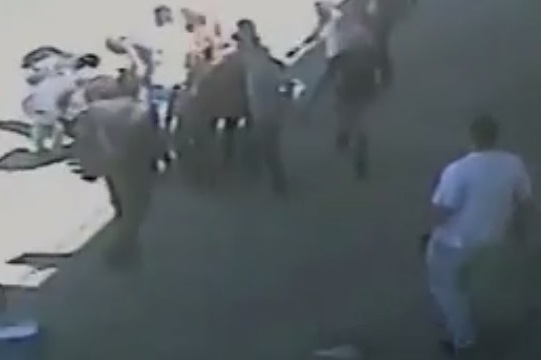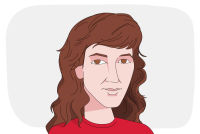On Nakba Day last year, Israeli Border Police killed two Palestinian teenage protesters and gravely injured a third. Two days after witnessing one of the shootings, I find myself at a memorial service in Vienna, honoring my relatives who perished in the Holocaust. The dizzying identity carousel never stops revolving.

It is the early afternoon and I am in a car with two companions, driving through the West Bank. It is Nakba Day 2014, and we are on our way to Beitunia, a Palestinian town next to Ofer Prison, in order to attend one of several demonstrations being held in memory of the ethnic cleansing of 1948.
As we drive through those hills and mounds that always remind me of piles of smashed terracotta, the occasional cloud of smoke can be seen rising up in the distance. Pink Floyd looms out of the car’s speakers. An army jeep drives past us; I turn round to watch it disappear, and I have a sense of driving through a tunnel that has no return route. I am acutely aware of my Israeli nationality; I feel as if I’m trespassing.
When we arrive in Beitunia, we – three Israelis – dislocate ourselves, shrugging off our nationality and slipping on another citizenship (real or imagined). We speak English, and let our outsiderness bring us inside. The scene is familiar: tear gas, smoke, flames, cracks and small explosions, running youths, running soldiers, kneeling soldiers, heard-but-not-seen soldiers, jeeps, cat-and-mouse, stones and bullets. Flags and helmets. Keffiyehs and guns. Palestine and Israel.
And something less familiar, at least for me – a different-sounding crack, more of a pop. People scatter, and then gravitate back towards the soldiers. More popping, and scattering; demonstrators near the front of the protest beckon at something unseen, and an ambulance that has been idling behind me flies towards them. People continue walking back from the front line. The ambulance hurtles back past us, and people’s heads turn to follow it before looking again in the opposite direction.
A young man, gas mask perched on the top of his head, and his t-shirt, hands and arms covered in blood, is walking in the middle of the road away from the soldiers. He is screaming and shouting, turning round every now and again and gesturing, before eventually collapsing against a wall in tears. A friend who was walking with him crouches alongside. People gather, paramedics run over. He is in shock; the blood is someone else’s.
Out of the impenetrable wall of discussions in Arabic happening all around, I hear someone say in English that the Israeli army had shot live bullets; a wound from a rubber bullet wouldn’t bleed so profusely. We drift back in the direction of the shooting, amid talk that the person who has been shot is young, and now in very grave condition.

Standing by, watching and listening, my blue ID card burning a hole in my bag, I suddenly understand Israel rather better than before: the extent of its hysterical paranoia, its red lines, its constant reliance on hatred for strength. This demonstration and the army’s response cry out that the fundamental founding reality of this country is one that Israelis are distantly aware of but cannot bear to face, like someone who has stepped on broken glass and dares not lift their foot to inspect the damage.
But there is no time to reflect on this in Beitunia, because we are back in the car on the way to Jerusalem. We do not know at that time that by the end of the afternoon, two Palestinian teenagers will have been shot dead, along with a third who is shot in the lung but survives. Our identity carousel spins again as we drive away: Muslim prayer beads swing from the rear-view mirror and Arabic music plays on the stereo. Eventually, after a traffic jam caused by road closures in Ramallah, we approach the entry back into Israel.
The checkpoint is the site of another demonstration. We drive through the flames of burning tires and our adopted identities melt away too; the music is switched off, the beads tucked into a compartment under the stereo. We are Israelis again, with an appropriate story prepared for the soldiers at the checkpoint – we were visiting friends in a settlement. If you can’t beat them, join them (temporarily).
In the shared taxi on the way back to Tel Aviv from Jerusalem, I read on my phone that a Palestinian teenager shot during the demonstration in Beitunia has died. I cannot stop my brain from drawing a line between what I saw and what I have just read. For the rest of the day, I’m not sure what I am, and not because I shuffled the deck so many times.
Eighteen hours later I am in the air, flying to Vienna for a memorial honoring members of my family who were killed in the Holocaust. I feel Jewish again, in a way that I don’t (or can’t) when I’m in Israel. I think to myself that identity is merely sleight of hand, or perhaps drag.
Two days later, surrounded by my family from around the world, and other people’s families from around the world, I listen to my great-grandmother’s niece describe to us all the last time she saw her father, before he was taken to a concentration camp in 1938. A survivor herself, she pays tribute to all those who were lost during the Holocaust, and tells us: “I want to say that their lives weren’t taken in vain, but they were. And today, the atrocities continue in other countries.”
We walk through Vienna’s streets under a grey sky, going from one house to another in the old Jewish district of Leopoldstadt in order to memorialize former residents who were taken and killed by the Nazis. It is raining, and we are on the other side of the solar system from Beitunia and its burning roads. The volume on the Nakba Day reel in my head dials down, and the cracks and explosions and tear gas fade away. Then a woman, speaking about a member of her family being remembered that day, ends her speech with “Am Yisrael Chai” (the people of Israel live), and a young man with a blood-stained shirt and a tear-stained face escapes from my memory and slips into my mind’s eye. Banquo in Leopoldstadt.
The carousel revolves again. In this 76-year weekend I am standing in the street on which two teenagers are shot dead for remembering, killed in my name, and standing in the street where my family were rounded up and eventually killed for their name. A strange wind blows from one memory to another, one people to another, one history to another. They are two tragedies that dare not speak each other’s name, and they will forever be our shadows.
Their lives were taken in vain.
A version of this post originally appeared on the author’s personal blog.


